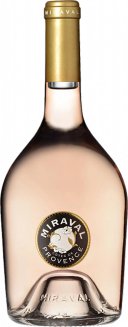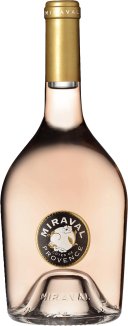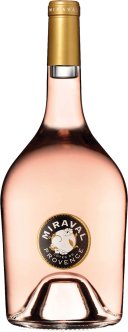Ott Mireille Coeur de Grain Rosé
In the 1930s, Marcel Ott was attracted to a very old property near the coastline and the intense blue of the Mediterranean. Overlooking the sea, Clos Mireille is in Londe les Maures close to Brégançon.
Related products
Miraval Côtes de Provence Rosé
Situated in the ancient village of Correns, the heart of Provence, Miraval is the magnificent château owned by Brad Pitt and Angelina Jolie Pitt. Surrounded by exclusive valley locations and exceptional terroir, thisýrosé is the result of aýcollaboration between the Jolie Pitts and la famille Perrin. Aýcomplex, flavoursome blend of cinsault, grenache, syrah and rolle, it's bursting with notes of raspberry, wild strawberries, citrus and melon, finishing with a fresh, vibrant acidity. Recently placed in Wine Spectator's Top 100, it's considered to be one of best examples ofýrosé in the world.
Caves D’Esclans Whispering Angel Rosé
Chateau d’Esclans is situated in the heart of Provence, northeast of St. Tropez. With his acquisition of the Château in 2006, Sacha Lichine’s vision was to create the greatest rosés in the world, igniting the “Rosé Renaissance”. Château d’Esclans is home to Whispering Angel which is made from grapes sourced from amongst the most choice Vineyards in the vicinity of the Esclans Valley and nearby in the Cotes de Provence region. Harvesting is only conducted during at night time to avoid the heat of the day & to keep the crop of grapes fresh. Upon arriving in the Cellars, grapes are sorted for both health and quality ensuring that the selected grapes are assessed accurately in terms of overall quality. The harvest takes place each September, where grapes, at their ripest, are selected, picked and carefully placed in small crates, chosen in order to avoid too many grapes at the top crushing grapes at the bottom. Once the grapes arrive to the cellars all grapes which go into vinification are de-stemmed and resemble each of the physical characteristics dictated by the wine maker including shape, size, colour and condition. This is verified by an optical eye camera which is programmed to detect whether grapes correspond to the established criteria. The grapes are then sent through a soft crush mechanism which punctures them in order for the juice inside to flow followed by their entering a heat exchange system which reduces their temperature from what can be as high as 29 degrees celsius down to 7-8 degrees. Temperature reduction ensures that freshness and vivacity are locked in which is key to ensure consistent temperature control making the grapes ready for closed circuit (nitrogen) pressing ensues which produces 3 grades of what is primarily free run juice. Nitrogen pressing ensures no oxidation is taking place during the pressing process known as an accumulation of details that is carefully planned and monitored. Depending on which grade of juice the press produces, the wine makers determine which will be used to make barrel fermented (aged) wine or stainless steel fermented wine. The different grades of juice differ in terms of skin contact which pertains exclusively to the first press while the next two have no skin contact and increase in intensity from one to the next. The overall affect is a clear, clean tannin free juice which gives the wines an agreeable characteristic and taste profile while ensuring that the colour is quite pale. As the individual juices from corresponding Barrels and Vats are selected and placed into half bottles, the technical team will taste through these unique juices and they will start to form opinions for which wines they should be used to make the new vintage. The information which comes from this step in the process is noted for referential purposes related to the next step, the assemblage. The last step is the assemblage or blending for Chateau d’Esclans and Caves d’Esclans wines. While there is little variation vintage to vintage, percentage of different grape varieties that will make up the ultimate blend will differ with each new vintage, however the taste profile remains the same. Made from Grenache, Cinsault and Rolle (Vermentino) grapes, its pale colour is pleasing to the eye and draws one in. The rewarding taste profile is full and lush while being bone dry with a smooth finish. A blend of the best free run juices and press juices, fermented and aged in stainless steel with temperature control. A beautifully pale pink, which is pleasing to the eye and draws one in. Flavours of fresh red berry fruit characteristics with floral notes and a ripe and fleshy feel on the palate. This popular rosé wine has great concentration, a smooth and round finish and no astringent aftertaste.
Chateau D'Esclans Rock Angel
Rock Angel is made from grapes primarily from the Vineyards of Chateau d’Esclans in addition to the most choice Vineyards in the vicinity of the Esclans Valley and nearby in the Cotes de Provence region. Harvesting is conducted in the morning for Estate cultivated grapes and during the night time for sourced grapes. Rich and racy on the palate. The use of partial oak aging adds a creamy feel and texture to this wine, and the flinty minerality embues it with another layer of complexity. Delicate red berry aromas with mineral notes, along with floral hints and a subtle spice. Powerful and elegant. Firm acidity with a long and silky finish.
M De Minuty
A splendid, pleasurable wine: The Grenahe and Cinsault blend form an aromatic harmony offering notes of peach and candied orange. The flavour is crisp and round on the palate.
Domaine du Gros' Noré Bandol Rouge
Although Bandol produces the most serious red wines in Provence, it still isn't a particularly well known appellation, and chances are most people haven't even heard of Bandol. This intriguing wine is a blend of Mourvèdre (80%) and a dash of Cinsault (15%) and old vine Carignan (5%).
Domaine Turenne Cotes de Provence 'Camille' rosé
Byott Cotes De Provence Rose
APPEARANCE: Pale and pretty in crystal-clear pink with orange undertones. AROMA: The nose is delicate and fruity with notes of white peach and apricot mixed with passion fruit and mango. PALATE: The taste is full, fresh and crisp with echoes of the fruity aroma amplified by citrus zest and sweet spices (cinnamon and cardamom). In 1896 Marcel Ott of Alsace found an estate which inspired him, Château de Selle in Tarandeau, Provence, where once olives, lavender and mulberries grew. Enjoying a unique microclimate, the wines are delicate and elegant with great depth. In the 1930s, Marcel Ott fell in love with the very old Clos Mireille, overlooking the sea at La Londe Les Maures, near Brégançon. The vines soon started producing distinctive yet subtle wines. Château Romassan in Bandol was acquired by the Ott family in 1956 and following years of terracing and replanting, produces robust, harmonious and long lived wines. Cur de Grain represents wine-making genius, and today the distinctive bottle evokes the memory of the elegant amphora of centuries past. Today, 120 years later, cousins Jean-François and Christian Ott dedicate their lives to their ancestors love for Provence. In 2004, Domaines Ott* joined Louis Roederer and its fabulous selection of wine craftsmen.
Chateau Roubine Premium Rosé AOP Côtes de Provence Cru Classé
Dom.Ott Clos Mireille Coeur de Grain Rose
Guigal Chateauneuf Du Pape
Guigal is one of the powerhouses of the Rhône and a name synonymous with beautifully crafted wines from some of the regions finest vineyard sites. Deep dark red. Spices and mature red fruits. Round tannins with powerful complexity. A rich unctuous wine with notes of mature plums, hazelnuts and red fruits. Overall: Very rich wine full of harmony and balance.























